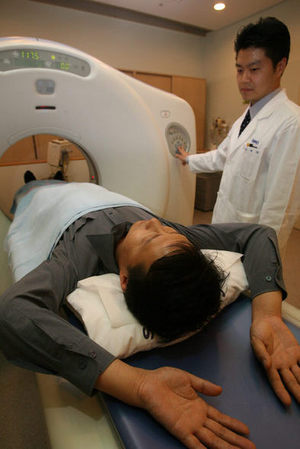Posted on : Jan.1,2007 15:46 KST
Modified on : Jan.2,2007 15:09 KST
 |
|
A patient taking a medical checkup
|
Faulty statistics corrected in 2nd report
The government announced on December 19 that a recipient of state-funded low-cost medical care cost the nation more than three times what it pays for a subscriber to the government’s insurance system. The announcement was followed by a series of measures by the Ministry of Health and Welfare to limit low-cost medical treatment for the underprivileged. However, the data used in the report turned out to bear many statistical problems.
Despite the clear fact that low-cost medical care will automatically cost more than care provided under an insurance system, it was found that the government report was skewed toward making the cost of providing reduced-price medical care appear even higher. For example, it did not reflect such major factors as the age and gender of those receiving either type of insurance, elements which have strong bearing on the type, cost, and frequency of medical treatment needed.
According to another set of statistics for 2005 health insurance services, 25.6 percent of those receiving low-cost medical care were senior citizens, whereas that age group only occupied 8.3 percent of those paying into the government insurance system. This sharp difference in number of senior citizens in each program would naturally result in higher costs for the reduced-price medical care system.
In addition, those receiving low-cost medical care needed more intensive medical treatment than those on the government insurance program. For example, 0.25 percent of low-cost medical care recipients were treated for stomach cancer, as compared to only 0.07 percent of those on the government insurance program. In the case of schizophrenia, the number of sufferers on the low-cost system was 42 times higher than the number of those in the national insurance system. For leukemia, this factor was 12.0 times higher, and for hemorrhage sufferers, it was 5.5 times higher.
The government insurance program operates like a co-pay system, in which the government covers a certain percentage of treatment cost and the individual makes up the difference, 28.5 percent of the cost, on average. Premiums are graduated on a progressive scale based on income. Low-income medical care recipients pay no premium, and must pick up an average of 13.5 or 25.6 percent of medical costs, based on their level of income.
The ministry took the criticisms of its data in mind and unveiled a new report on December 31, in which the cost of a reduced-price medical user was only 1.48 times the cost of a member of the national insurance plan.
"We are sorry that we unveiled the wrong data, but the measures that we had announced to limit low-cost medical services are still needed," a ministry official said.
Please direct questions or comments to [englishhani@hani.co.kr]

